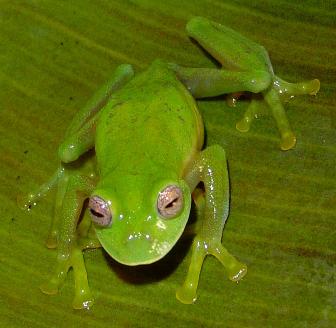


|
Centrolenidae :
Most species are small (30mm) with one exception, Centrolene gekkoideum, which attains a length of 77 mm. Most centrolenid frogs are a shade of green, light lime green to dark green. Members of this family also have green bones as a result of green bile salts. Studies have shown that glass frogs contain a unique pigment in their skin that reflects the same wavelength infrared radiation that plants do, possibly another adaptation for concealment. Eggs are usually deposited on rocks or plants overhanging water, and are sometimes guarded by territorial males. The larvae drop into the water upon hatching and burrow in the sand or detritus at the bottom. This group is composed of 3 genera. Species of this group occur from Venezuela down through Bolivia, Argentina, and southern Brazil in high montane habitats with streams. Morphological characters uniting this clade are: 1) astragalus and calcaneum completely fused (convergent with Pelodytidae); 2) dilated medial process on third metacarpal; 3) T-shaped terminal phalanges (convergent with other groups); 4) 8 presacral vertebrae; 5) ribs absent; 6) pectoral girdle arciferal; 7) palatines present; 8) ventral side and sometimes GI organs transparent
Genus :
Centrolene (42 species)
Cochranella (63 species)
Hyalinobatrachium (37 species) |
